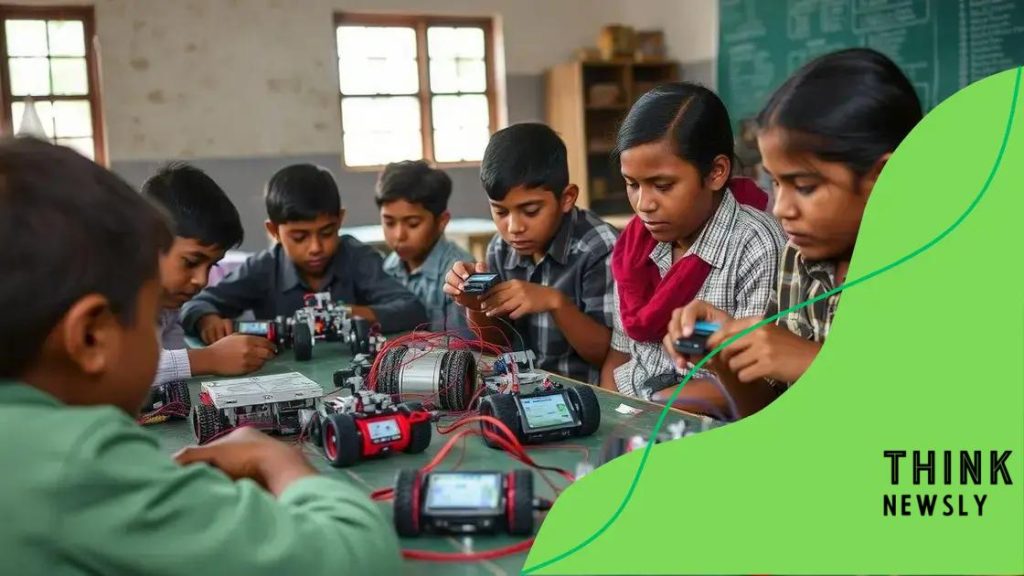Robotics labs added to rural schools: a new frontier

Anúncios
Integrating robotics labs into rural schools enhances student engagement, fosters interest in STEM, and prepares students for future technological careers through hands-on learning experiences.
Robotics labs added to rural schools present a transformative chance for students to dive into technology. Imagine young minds engaging with hands-on learning, sparking creativity and innovation. How could this change the community?
Anúncios
the impact of robotics in rural education
Incorporating robotics into rural education has a significant impact on student learning and engagement. Students are not only learning about technology but also developing critical thinking skills. Robotics programs introduce hands-on experiences that can lead to a better understanding of complex concepts.
Enhancing Learning Experiences
With the adoption of robotics labs, rural students gain access to advanced tools and resources previously unavailable. This creates a more interactive learning environment. Students become eager participants rather than passive listeners.
Building Essential Skills
- Coding and Programming: Students learn essential coding skills that are crucial in today’s job market.
- Problem-Solving: Tackling robotics projects teaches students how to approach and solve challenges effectively.
- Collaboration: Working in teams fosters communication and teamwork, vital skills for future success.
Moreover, robotics can spark interest in STEM fields. This is particularly important in rural areas where opportunities in science and technology may be limited. By engaging students early with robotics, we set the foundation for future innovators.
Anúncios
Through robotics, students also gain confidence in their abilities. They see tangible results from their work, which motivates them to pursue further learning. More importantly, it helps nurture an interest in lifelong learning, which can benefit them and their communities.
Creating Community Engagement
When local schools adopt robotics programs, it often results in greater community involvement. Parents and community members frequently participate in workshops or exhibitions, further bridging the gap between education and real-world application. This creates an ecosystem where education thrives.
how robotics labs enhance student engagement
Robotics labs play a pivotal role in enhancing student engagement, especially in rural schools. By providing a hands-on learning environment, students become excited about their education. In these labs, students can explore technology in a practical way, which makes the learning experience more enjoyable.
Interactive Learning Environment
The interactive nature of robotics labs allows students to work on projects that spark their curiosity. This involvement helps to develop a love for STEM (Science, Technology, Engineering, and Mathematics). When students can build and program robots, they see the results of their efforts in real-time.
Fostering Critical Thinking
Students in robotics labs are often faced with various challenges that require innovative solutions. This fosters critical thinking and problem-solving abilities. Engaging with robotics encourages students to ask questions and seek out answers, which deepens their understanding.
- Real-World Applications: Students learn how robotics relates to real-world problems.
- Team Collaboration: Working on group projects promotes teamwork and communication skills.
- Motivation to Learn: Success in building and programming robots boosts confidence.
Moreover, the excitement of participating in competitions or showcases can further motivate students. They take pride in their achievements and the creativity they express through their projects. This positive reinforcement encourages continued engagement in their studies.
Hands-on projects allow students to apply theoretical knowledge in a practical setting. The act of building and programming robots makes concepts easier to grasp. When students see their work in action, they are more likely to retain information and develop a passion for learning.
success stories from rural schools with robotics

Many rural schools have embraced robotics programs, leading to inspiring success stories. These stories showcase how robotics can transform education and empower students in ways they never imagined. From competitions to technological innovation, the results are impressive.
Empowered Students
Students in these programs have gained confidence through their participation. They work on exciting projects that challenge their skills and creativity. For instance, a group of students built a robot for a local science fair, winning first place. Their success not only boosted their morale but also encouraged other students to join the robotics team.
Community Impact
Robotics programs have also fostered a sense of community. Schools often host workshops and events that involve parents and local businesses. This collaboration helps to strengthen community ties and support for the school. In one instance, a rural school partnered with a local tech company to create a mentorship program. This initiative provided students with guidance and real-world experience.
- Increased Interest in STEM: Success in robotics can lead to greater interest in science and technology fields.
- Skill Development: Students learn valuable skills that prepare them for future careers.
- Future Opportunities: Success stories can create pathways for scholarships and internships.
One remarkable example involves a small school that launched a robotics competition. The event drew participants from neighboring communities. As a result, students gained recognition and were invited to regional competitions. They became role models, inspiring peers and younger students.
Sharing these success stories helps to promote robotics in rural schools. They highlight the positive changes that can occur when students are given the tools and support they need. More schools are now considering adopting similar programs to enhance their educational offerings.
challenges faced in implementing robotics programs
Implementing robotics programs in rural schools comes with unique challenges. These obstacles can affect the success and sustainability of the initiatives. By understanding these issues, schools can find ways to overcome them and improve educational outcomes.
Limited Resources
One major challenge is the lack of resources. Many rural schools struggle with budget constraints, making it difficult to acquire robotics kits and other necessary equipment. Without proper funding, it becomes challenging to start or maintain these programs. Schools often need to seek grants or community support to help alleviate these financial burdens.
Teacher Training
Another significant hurdle is the availability of trained educators. Teachers may not have sufficient knowledge or experience in robotics and technology. This can limit their ability to teach effectively. To address this, schools can arrange workshops and training sessions for teachers to build their skills and confidence in robotics-related subjects.
- Establishing Partnerships: Creating partnerships with local businesses can provide resources and expertise.
- Professional Development: Ongoing training for teachers enhances their ability to deliver quality instruction.
- Community Support: Involving parents and local stakeholders helps gain buy-in for the program.
Additionally, rural schools might face issues with access to technology and internet connectivity. Many robotics programs rely on online resources and collaborative tools, making internet access vital. Without reliable connectivity, students may miss out on valuable learning experiences.
Another common challenge is student engagement. Some students may be hesitant to participate due to a lack of confidence or interest. Schools can encourage participation by showcasing robotics in interesting ways, such as robotics competitions or hands-on demonstrations. By making learning engaging, students are more likely to get involved.
future prospects for robotics in rural curricula
The future of robotics in rural curricula looks promising as educational leaders recognize its value. Integrating robotics into school programs can enhance learning opportunities for students. As technology advances, schools can adapt by incorporating newer tools and teaching methods.
Increased Funding and Resources
One significant trend is the potential for increased funding for robotics programs. Governments and organizations are beginning to see the benefits of investing in technology education. This financial support can provide schools with the necessary resources to develop effective robotics programs.
Emphasis on STEM Education
The growing emphasis on STEM education is another factor that will shape the future of robotics in rural schools. With a focus on science, technology, engineering, and mathematics, schools are encouraged to integrate robotics as a core part of the curriculum. This not only engages students but also prepares them for careers in high-demand fields.
- Expanding Curriculum: Schools can expand their curriculum to include robotics alongside traditional subjects.
- Hands-on Learning: Incorporating robotics promotes hands-on learning experiences that deepen understanding.
- Career Pathways: Early exposure to robotics can inspire students to pursue careers in technology and engineering.
Moreover, advancements in technology continue to make robotics more accessible. As prices become more affordable and resources become more available, rural schools can implement robotics programs that were once out of reach. Students will have the chance to learn with state-of-the-art technology, keeping them competitive with their urban counterparts.
Community involvement will also play a crucial role. Partnerships between schools and local businesses can enhance robotics education. These collaborations can provide students with real-world experiences and mentorship opportunities, creating a more engaging learning environment.
robotics in rural schools is bright and filled with opportunities. As funding increases and technology becomes more accessible, schools can enhance their curricula and engage students effectively. Robotics not only fosters interest in STEM but also prepares students for future careers. By overcoming challenges and leveraging community support, rural schools can create enriching learning environments. Together, these elements will shape a positive trajectory for students in rural areas, inspiring the next generation of innovators and problem solvers.
FAQ – Frequently Asked Questions about Robotics in Rural Schools
What are the main benefits of implementing robotics programs in rural schools?
Robotics programs enhance student engagement, encourage interest in STEM fields, and provide hands-on learning experiences that prepare students for future careers.
How can rural schools secure funding for robotics initiatives?
Rural schools can seek grants, engage local businesses, and collaborate with community organizations to obtain funding for robotics resources.
What skills do students develop through participating in robotics programs?
Students develop critical thinking, problem-solving, coding, and teamwork skills while working on robotics projects.
How can communities support robotics education in rural schools?
Communities can support by volunteering for mentorship, providing resources, and participating in events that promote robotics education.





